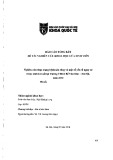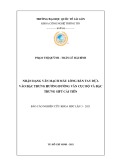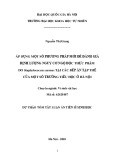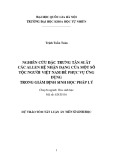
Page 1 of 2
(page number not for citation purposes)
Available online http://ccforum.com/content/12/1/104
Abstract
Increased microvascular permeability resulting in tissue edema is a
hallmark of sepsis-related microcirculatory failure, and leukocyte–
endothelium interaction is thought to assume major importance in
this context. However, the role of nitric oxide (NO) in the interplay
of inflammation, leukocyte–endothelium interaction and increased
microcirculatory permeability is still a matter of debate. Hollenberg
et al. now report, in the previous issue of Critical Care, that neither
genetic deletion nor pharmacologic blockade of the inducible
isoform of the NO synthase (iNOS) affected the sepsis-related
aggravation of leukocyte rolling and adhesion, whereas iNOS
inhibition attenuated microvascular permeability. The authors
conclude that excess NO resulting from iNOS activation is
important in modulating vascular permeability during sepsis, but
that this effect is independent of its action on leukocytes.
Increased microvascular permeability resulting in tissue
edema is a hallmark of sepsis-related microcirculatory failure,
and in this context leukocytes are thought to assume major
importance. However, the role of nitric oxide (NO) in the
interplay of inflammation, leukocyte–endothelium interaction
and increased microcirculatory permeability is still a matter of
debate. It is well established that NO has a pivotal role in the
regulation of vasomotor tone as well as in host defense and
immune function, and abundant literature is available on both
its protective and its detrimental properties, which depend on
the source of its release (for example, isoenzyme activation),
the timing and the amount of its production, and the redox
status of the surrounding milieu. In the previous issue of
Critical Care, Hollenberg et al. [1] added another piece to
this complex puzzle. Using a well-established, clinically
relevant murine model of resuscitated, hyperdynamic sepsis
resulting from cecal ligation and puncture (CLP) [2], the
authors studied the effects of both genetic deletion and
pharmacologic blockade of the inducible isoform of the NO
synthase (iNOS) on leukocyte adhesion and rolling as well as
on microvascular leakage. In this model, the authors had
previously shown that iNOS–/– mice presented with improved
microvascular catecholamine responsiveness and, ultimately,
enhanced survival [2]. As expected, in the present study CLP
itself aggravated leukocyte rolling and adhesion. Interestingly,
deletion of iNOS did not affect this response, whereas it
attenuated microvascular permeability. In sham-operated
control mice, iNOS-derived NO inhibited the interaction
between leukocytes and endothelial cells (rolling and
adhesion), but not microvascular permeability. The authors
concluded that excess NO resulting from iNOS activation is
important in modulating vascular permeability during sepsis,
but that this effect is independent of its action on leukocytes.
How do these findings compare with the available literature
on the role of NO in leukocyte–endothelium interaction and
microvascular permeability?
More than a decade ago, Kubes et al. showed that non-
selective NO synthase inhibition increased leukocyte
adherence [3]. This effect was closely related to oxidative
stress resulting from an enhanced production of superoxide
radicals [4], thus demonstrating the importance of NO as an
oxygen radical scavenger. In rats with CLP, non-selective NO
synthase inhibition also increased leukocyte migration [5].
Activation of iNOS seemed to be responsible for the protec-
tive properties of NO, because iNOS–/– mice challenged with
lipopolysaccharide presented with a comparably increased
accumulation of pulmonary leukocytes [6]. Furthermore,
iNOS–/– caused enhanced pulmonary inflammation after
instillation of lipopolysaccharide into the lung [7], whereas
wild-type controls and mice lacking endothelial NO synthase
(eNOS–/–) presented with similar less pronounced
Commentary
Nitric oxide, leukocytes and microvascular permeability:
causality or bystanders?
Balázs Hauser1,2, Martin Matejovic3and Peter Radermacher1
1Sektion Anästhesiologische Pathophysiologie und Verfahrensentwicklung, Universitätsklinikum, Parkstrasse 11, 89073 Ulm, Germany
2Aneszteziológiai és Intenzív Terápiás Klinika, Semmelweis Egyetem, H-1125 Kietvolgyi, Budapest, Hungary
31. Interni klinika, Karlova univerzita Praha, Lekarska fakulta a Fakultni nemocnice, Allej Svobody 80, 30460 Plzen, Czech Republic
Corresponding author: Peter Radermacher, peter.radermacher@uni-ulm.de
Published: 16 January 2008 Critical Care 2008, 12:104 (doi:10.1186/cc6214)
This article is online at http://ccforum.com/content/12/1/104
© 2008 BioMed Central Ltd
See related research by Hollenberg et al., http://ccforum.com/content/11/6/R125
CLP = cecal ligation and puncture; eNOS = endothelial nitric oxide synthase; iNOS = inducible nitric oxide synthase; NO = nitric oxide.

Page 2 of 2
(page number not for citation purposes)
Critical Care Vol 12 No 1 Hauser et al.
inflammatory responses. Finally, iNOS–/– mice subjected to
lethal CLP showed even more pronounced leukocyte rolling
and adhesion than wild-type controls treated with the non-
selective NO synthase blocker aminoguanidine [8]. Because
NO affected only minimally the most important adhesion
molecules (P-selectin, E-selectin and vascular cell adhesion
molecule-1) regulating leukocyte response, Hickey et al.
concluded that iNOS-related changes affecting leukocyte
behavior in the microcirculation are due to an altered leukocyte
function rather than an altered endothelial function [9].
The picture is far less straightforward with regard to
microvascular permeability. Clearly, Kubes and Granger [10]
elegantly demonstrated that the non-selective NO blockade
markedly increased fluid leakage into the extravascular space.
This effect was due not only to increased microvascular
hydrostatic pressure but also to increased microvascular
permeability [10]. Nevertheless, Paul Kubes also emphasized
the ‘continuing dilemma of NO and microvascular permea-
bility’ [11] due to the compelling evidence that endogenous
NO may either decrease or increase fluid leakage [12]. In
fact, even inhaled NO was reported to increase epithelial
permeability and alveolar fluid leakage in rats with pneumonia
[13], a rather intriguing observation because Benzing et al.
[14] had reported decreased transvascular albumin flux in
patients with acute lung injury, which was due at least in part
to a fall in the pulmonary effective capillary pressure; that is,
the microvascular hydrostatic pressure. Differentiating
between the constitutive endothelial, and inducible NO
synthase isoforms, namely eNOS and iNOS, adds to the
complexity: the present data by Hollenberg et al. clearly
indicate a major role of iNOS, whereas other authors
investigating both eNOS–/– and iNOS–/– animals found that
iNOS was associated with protective rather than deleterious
properties; in fact, in the present study, iNOS–/– mice
challenged with CLP presented with less microvascular
leakage, whereas eNOS–/– mice were protected against
tissue edema after intrapulmonary instillation of lipopoly-
saccharide [7], zymosan injection into the paw [15], and
injection of platelet-activating factor into the mesentery [16].
Consequently, what do we learn for clinical practice? Or, in
other words, shall we say ‘No to iNOS’ so as to attenuate
sepsis-induced tissue edema resulting from microvascular
failure? Data from clinically relevant, resuscitated models of
both genetic and pharmacologic iNOS inhibition [1,2] clearly
favor this approach, and similar conclusions can be drawn
from existing reports on large animals [17]. Nevertheless, it
must be emphasized that ‘a mouse is not a man’: in rodents,
endogenous NO production is higher by one or two orders of
magnitude than in human beings [18]. In addition, it must be
noted that up to now clinical data have not supported a direct
relation between NO release and the capillary filtration
coefficient, a noninvasive index of microvascular permeability
[19]. Consequently, a definite answer is still lacking.
Competing interests
The authors declare that they have no competing interests.
References
1. Hollenberg SM, Guglielmi M, Parrillo JE: Discordance between
microvascular permeability and leukocyte dynamics in septic
inducible nitric oxide synthase deficient mice. Crit Care 2007,
11:R125.
2. Hollenberg SM, Broussard M, Osman J, Parrillo JE: Increased
microvascular reactivity and improved mortality in septic mice
lacking inducible nitric oxide synthase. Circ Res 2000, 86:774-
779.
3. Kubes P, Suzuki M, Granger DN: Nitric oxide: an endogenous
modulator of leukocyte adhesion. Proc Natl Acad Sci USA
1991, 88:4651-4655.
4. Gaboury J, Woodman RC, Granger DN, Reinhardt P, Kubes P:
Nitric oxide prevents leukocyte adherence: role of superoxide.
Am J Physiol 1993, 265:H862-H867.
5. Sundrani R, Easington CR, Mattoo A, Parrillo JE, Hollenberg SM:
Nitric oxide synthase inhibition increases venular leukocyte
rolling and adhesion in septic rats. Crit Care Med 2000, 28:
2898-2903.
6. Hickey MJ, Sharkey KA, Sihota EG, Reinhardt PH, Macmicking JD,
Nathan C, Kubes P: Inducible nitric oxide synthase-deficient
mice have enhanced leukocyte–endothelium interactions in
endotoxemia. FASEB J 1997, 11:955-964.
7. Speyer CL, Neff TA, Warner RL, Guo RF, Sarma JV, Riedemann
NC, Murphy ME? Murphy HS, Ward PA: Regulatory effects of
iNOS on acute lung inflammatory response in mice. Am J
Pathol 2003, 163:2319-2328.
8. Benjamim CF, Silva JS, Fortes ZB, Oliveira MA, Ferreira SH,
Cunha FQ: Inhibition of leukocyte rolling by nitric oxide during
sepsis leads to reduced migration of active microbicidal neu-
trophils. Infect Immun 2002, 70:3602-3610.
9. Hickey MJ, Granger DN, Kubes P: Inducible nitric oxide syn-
thase (iNOS) and regulation of leukocyte/endothelial cell
inrteractions: studies in iNOS-deficient mice. Acta Physiol
Scand 2001, 173:119-126.
10. Kubes P, Granger DN: Nitric oxide modulates microvascular
permeability. Am J Physiol 1992, 262:H611-H615.
11. Kubes P: Nitric oxide and microvascular permeability: a con-
tinuing dilemma. Eur Respir J 1997, 10:4-5.
12. Kubes P: Nitric oxide affects microvascular permeability in the
intact and inflamed vasculature. Microcirculation 1995, 2:235-
244.
13. Ader F, Le Berre R, Lancel S, Faure K, Viget NB, Nowak E, Niviere
R, Guery B: Inhaled nitric oxide increases endothelial perme-
ability in Pseudomonas aeruginosa pneumonia. Intensive Care
Med 2007, 33:503-510.
14. Benzing A, Bräutigam P, Geiger K, Loop T, Beyer U, Moser E:
Inhaled nitric oxide reduces pulmonary transvascular albumin
flux in patients with acute lung injury. Anesthesiology 1995, 83:
1153-1161.
15. Bucci M, Roviezzo F, Posadas I, Yu J, Parente L, Sessa WC,
Ignarro LJ, Cirino G: Endothelial nitric oxide synthase activa-
tion is critical for vascular leakage during acute inflammation
in vivo.Proc Natl Acad Sci USA 2005, 102:904-908.
16. Hatakeyama T, Pappas PJ, Hobson RW, Boric HI, Sessa WC,
Durán WN: Endothelial nitric oxide synthase regulates
microvascular hyperpermeability in vivo.J Physiol 2006, 574:
275-281.
17. Hauser B, Bracht H, Matejovic M, Radermacher P, Venkatesh B:
Nitric oxide synthase inhibition in sepsis? Lessons learned
from large-animal studies. Anesth Analg 2005, 101:488-498.
18. Reade MC, Young JD: Of mice and men (and rats): implica-
tions of species and stimulus differences for the interpreta-
tion of studies of nitric oxide in sepsis. Br J Anaesth 2003, 90:
115-118.
19. Dhillon SS, Mahadevan K, Bandi V, Zheng Z, Smith W, Rumbaut
RE: Neurophils, nitric oxide, and microvascular permeability in
severe sepsis. Chest 2005, 128:1706-1712.


























